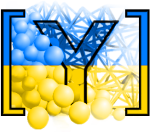yade.qt module¶
Common initialization core for yade.
This file is executed when anything is imported from yade for the first time. It loads yade plugins and injects c++ class constructors to the __builtins__ (that might change in the future, though) namespace, making them available everywhere.
- class yade.qt._GLViewer.GLViewer¶
- __init__()¶
Raises an exception This class cannot be instantiated from Python
- property axes¶
Show arrows for axes.
- center((GLViewer)arg1[, (bool)median=True[, (float)suggestedRadius=-1.0]]) None :¶
Center view. View is centered either so that all bodies fit inside (median = False), or so that 75% of bodies fit inside (median = True). If radius cannot be determined automatically then suggestedRadius is used.
- close((GLViewer)arg1) None¶
- property eyePosition¶
Camera position.
- fitAABB((GLViewer)arg1, (Vector3)mn, (Vector3)mx) None :¶
Adjust scene bounds so that Axis-aligned bounding box given by its lower and upper corners mn, mx fits in.
- fitSphere((GLViewer)arg1, (Vector3)center, (float)radius) None :¶
Adjust scene bounds so that sphere given by center and radius fits in.
- property fps¶
Show frames per second indicator.
- property grid¶
Display square grid in zero planes, as 3-tuple of bools for yz, xz, xy planes.
- loadState((GLViewer)arg1[, (str)stateFilename='.qglviewer.xml']) None :¶
Load display parameters from file saved previously into.
- property lookAt¶
Point at which camera is directed.
- property ortho¶
Whether orthographic projection is used; if false, use perspective projection.
- saveSnapshot((GLViewer)arg1, (str)filename) None :¶
Save the current view to image file
- saveState((GLViewer)arg1[, (str)stateFilename='.qglviewer.xml']) None :¶
Save display parameters into a file. Saves state for both GLViewer and associated OpenGLRenderer.
- property scale¶
Scale of the view (?)
- property sceneRadius¶
Visible scene radius.
- property screenSize¶
Size of the viewer’s window, in screen pixels
- property selection¶
- showEntireScene((GLViewer)arg1) None¶
- property timeDisp¶
Time displayed on in the vindow; is a string composed of characters r, v, i standing respectively for real time, virtual time, iteration number.
- property upVector¶
Vector that will be shown oriented up on the screen.
- property viewDir¶
Camera orientation (as vector).
- yade.qt._GLViewer.Renderer() OpenGLRenderer¶
Return the active OpenGLRenderer object.
- yade.qt._GLViewer.center([(float)suggestedRadius=-1.0[, (Vector3)gridOrigin=Vector3(0, 0, 0)[, (Vector3)suggestedCenter=Vector3(0, 0, 0)[, (int)gridDecimalPlaces=4]]]]) None¶
Center all views.
- Parameters:
suggestedRadius – optional parameter, if provided and positive then it will be used instead of automatic radius detection. This parameter affects the (1) size of grid being drawn (2) the Z-clipping distance in OpenGL, it means that if clipping is too large and some of your scene is not being drawn but is “cut” or “sliced” then this parameter needs to be bigger.
gridOrigin – optional parameter, if provided it will be used as the origin for drawing the grid. Meaning the intersection of all three grids will not be at 0,0,0; but at the provided coordinate rounded to the nearest gridStep.
suggestedCenter – optional parameter, if provided other than (0,0,0) then it will be used instead of automatic calculation of scene center using bounding boxes. This parameter affects the drawn rotation-center. If you try to rotate the view, and the rotation is around some strange point, then this parameter needs to be changed.
gridDecimalPlaces – default value=4, determines the number of decimal places to be shown on grid labels using stringstream (extra zeros are not shown).
Note
You can get the current values of all these four arguments by invoking command: qt.centerValues()
- yade.qt._GLViewer.centerValues() dict¶
- Returns:
a dictionary with all parameters currently used by
yade.qt.center(…), see qt.center or typeyade.qt.center?for details. Returns zeros if view is closed.
- yade.qt._GLViewer.views() list¶
- Returns:
a list of all open qt.GLViewer objects
If one needs to exactly copy camera position and settings between two different yade sessions, the following commands can be used:
v=yade.qt.views()[0] ## to obtain a handle of currently opened view. v.lookAt, v.viewDir, v.eyePosition, v.upVector ## to print the current camera parameters of the view. ## Then copy the output of this command into the second yade session to reposition the camera. v.lookAt, v.viewDir, v.eyePosition, v.upVector = (Vector3(-0.5,1.6,0.47),Vector3(-0.5,0.6,0.4),Vector3(0.015,0.98,-0.012),Vector3(0.84,0.46,0.27)) ## Since these parameters depend on each other it might be necessary to execute this command twice.
Also one can call qt.centerValues() to obtain current settings of axis and scene radius (if defaults are not used) and apply them via call to qt.center in the second yade session.
This cumbersome method above may be improved in the future.
